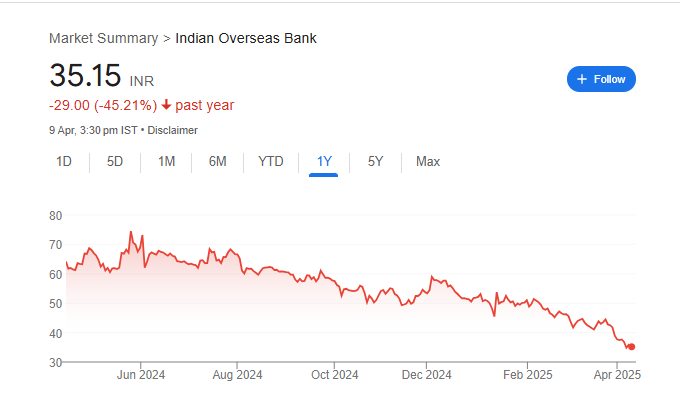IOB Share Price Target 2025 – Share Market Update
Indian Overseas Bank (IOB) is a public sector bank in India that offers a wide range of banking and financial services to individuals, businesses, and government organizations. Headquartered in Chennai, IOB has a strong presence across the country through its large network of branches and ATMs. The bank focuses on retail banking, corporate loans, and digital services to serve its diverse customer base. IOB Share Price on NSE as of 11 April 2025 is 35.15 INR.
Current Market Overview Of IOB Share
- Open: 35.75
- High: 35.90
- Low: 35.00
- Mkt cap: 67.77KCr
- P/E ratio: 21.34
- Div yield: N/A
- 52-wk high: 75.55
- 52-wk low: 33.50
IOB Share Price Chart

Shareholding Pattern For IOB
- Promoter: 94.61%
- FII: 0.22%
- DII: 2.93%
- Public: 2.25%
IOB Share Price Target Tomorrow
| IOB Share Price Target Years | IOB Share Price Target Months | IOB Share Price |
| IOB Share Price Target 2025 | April | ₹40 |
| IOB Share Price Target 2025 | May | ₹45 |
| IOB Share Price Target 2025 | June | ₹50 |
| IOB Share Price Target 2025 | July | ₹55 |
| IOB Share Price Target 2025 | August | ₹60 |
| IOB Share Price Target 2025 | September | ₹65 |
| IOB Share Price Target 2025 | October | ₹70 |
| IOB Share Price Target 2025 | November | ₹75 |
| IOB Share Price Target 2025 | December | ₹80 |
Key Factors Affecting IOB Share Price Growth
Indian Overseas Bank (IOB) has experienced notable share price growth in recent times, driven by several key factors:
-
Strong Loan Book Growth
IOB reported a year-on-year increase of 19.81% in its advances, surpassing its five-year compound annual growth rate (CAGR) of 11.95%. This indicates robust lending activity and a healthy demand for credit, contributing positively to the bank’s revenue and investor confidence.
-
Improved Asset Quality
The bank has made significant strides in reducing its non-performing assets (NPAs). Over the past four years, the gross NPA ratio has declined to 3.1%, and the net NPA ratio has improved to 0.57%. This enhancement in asset quality reflects better credit risk management and financial stability.
-
Government Stake Reduction Plans
To comply with the Securities and Exchange Board of India’s (SEBI) minimum public shareholding norms, the Indian government plans to reduce its stake in IOB below 75% by August 2026. This move is expected to increase the bank’s free float, potentially enhancing liquidity and attracting more institutional investors.
-
Consistent Profitability
IOB has demonstrated consistent profitability, with a five-year net profit growth rate of 18.02% and a return on equity (ROE) of 10.57%. These figures indicate efficient management and a solid financial foundation, which are attractive to investors seeking stable returns.
-
Expansion Initiatives
After a decade-long pause, IOB has resumed its expansion by adding 90 branches in the current fiscal year and planning to open 100 more in 2025–26. This strategic growth aims to increase the bank’s market presence and customer base, potentially leading to higher revenues.
-
Positive Market Sentiment
IOB’s share price has risen significantly, reflecting positive market sentiment. Factors contributing to this optimism include expectations of improved earnings, better return on assets (ROA), and increased foreign ownership. Such investor confidence can drive further share price appreciation.
Risks and Challenges for IOB Share Price
Investing in Indian Overseas Bank (IOB) shares involves understanding various risks and challenges that could influence its stock performance:
-
Regulatory Challenges
IOB has encountered regulatory issues, such as a significant Goods and Services Tax (GST) demand notice of ₹699.52 crore from Chennai authorities. Such substantial tax liabilities can impact the bank’s financial health and investor confidence.
-
Share Price Volatility
The bank’s shares have experienced notable fluctuations, including a 9% drop amid high trading volumes. Such volatility can affect investor sentiment and the perceived stability of the stock.
-
Market Underperformance
IOB’s stock has underperformed compared to the broader market, with a 3.67% decline on a particular day, while the Sensex showed a positive performance. Consistent underperformance may deter potential investors.
-
High Operating Expenses
The bank’s financials reveal significant expenditures, with 59.13% of operating revenues allocated to interest expenses and 25.53% towards employee costs. High operating costs can limit profitability and affect share value.
-
Decline in Corporate Credit
IOB has experienced a notable decline in corporate credit, which fell by 19.63%. A reduction in corporate lending can impact the bank’s revenue streams and growth prospects.
-
Intrinsic Value Concerns
Analyses suggest that IOB’s stock may be overvalued by approximately 36% compared to its intrinsic value. This discrepancy indicates potential overpricing, which could lead to future price corrections.
Read Also:- HPCL Share Price Target 2025 – Share Market Update

